In today’s fast-paced world, finding the time and energy to cook healthy meals can feel like a constant battle-especially when you’re trying to lose weight. That’s where meal prepping for weight loss becomes a game-changer. By planning and preparing your meals ahead of time, you not only save time during the week but also stay in control of your portions, ingredients, and overall calorie intake.
Whether you’re juggling a busy work schedule, family responsibilities, or just trying to avoid takeout temptations, meal prepping offers a simple, sustainable strategy to support your weight loss goals. In this article, we’ll walk you through easy, delicious recipes and smart prepping techniques that keep your nutrition on point—without spending hours in the kitchen or breaking the bank.
Ready to simplify your routine and stay on track? Let’s dive into how meal prepping can make healthy eating a no-brainer.
Why Meal Prepping Works for Weight Loss
Meal prepping isn’t just about convenience—it’s a powerful nutritional strategy that helps eliminate guesswork, reduce impulsive food choices, and align your eating habits with your health goals. Let’s break down the science and practical benefits behind why it’s so effective.
Portion Control Made Easy
One of the biggest challenges in weight loss is managing portion sizes. When you prepare your meals in advance, you’re not just choosing the right ingredients—you’re also deciding exactly how much to eat. This reduces the risk of overeating or underestimating calorie intake, a common issue when dining out or improvising meals at home.
Reduces Decision Fatigue and Cravings
Willpower weakens throughout the day, especially when you’re hungry and options are limited. Meal prepping eliminates this friction. When your meals are already prepared, you’re far less likely to grab something unhealthy or high in calories out of convenience.
This strategy minimizes decision fatigue—the psychological wear that leads people to make poor food choices when faced with too many options. By simplifying your daily food decisions, you’re more likely to stick to your plan.
Encourages Nutrient-Dense Choices
Meal prepping gives you the power to design balanced meals rich in lean proteins, fiber, healthy fats, and complex carbohydrates. A study by the National Institutes of Health found that people who consistently plan their meals tend to eat fewer ultra-processed foods and maintain a more nutrient-dense diet.
Saves Time, Money, and Energy
While meal prepping takes a bit of effort upfront, it drastically reduces time spent cooking and cleaning during the week. Planning your meals also prevents impulse grocery purchases and food waste—saving both money and stress.
Getting Started: Essential Tools and Prep Strategies
Before diving into the recipes, it’s important to set yourself up for success. A streamlined kitchen setup and some smart prep habits can make meal prepping for weight loss efficient, enjoyable, and sustainable. Here’s how to build a solid foundation.
Must-Have Tools for Meal Prep Success
Having the right equipment is half the battle. While you don’t need a professional kitchen, a few basic tools can make your process much smoother:
- Glass or BPA-free plastic containers (with compartments if possible)
- A reliable kitchen scale
- Measuring cups and spoons
- A quality chef’s knife and cutting board
- Slow cooker, air fryer, or Instant Pot (for time-saving batch cooking)
Time-Saving Prep Methods
Meal prep doesn’t have to mean cooking all Sunday. There are several time-efficient approaches:
- Batch Cooking: Make large quantities of a dish (e.g., chili, roasted vegetables, grilled chicken) and portion it out.
- Ingredient Prep: Chop, wash, and portion ingredients so they’re ready for quick assembly later.
- Cook Once, Eat Twice: Plan meals that share ingredients (like quinoa or roasted veggies) across multiple dishes.
Planning and repetition are your friends. Try prepping 2–3 days’ worth at first before expanding to a full week.
Storage and Shelf-Life Tips
Keeping your meals fresh is crucial. Store food in airtight containers and follow this general guide:
- Fridge: Cooked proteins and grains last 3–4 days. Leafy greens and chopped veggies stay fresh 3–5 days.
- Freezer: Stews, soups, and proteins can be frozen up to 3 months.
Create a Weekly Plan
Having a structure prevents guesswork. Plan meals around your schedule, workouts, or even cravings. Mix and match proteins, veggies, and grains to avoid boredom.
Simple and Tasty Recipes for Weight Loss Meal Prep
Healthy doesn’t have to mean boring. The key to sustainable weight loss is finding meals you enjoy and can stick with consistently. Below are simple, balanced recipes you can prep in advance—each designed to be low in calories, rich in nutrients, and full of flavor.
Chicken Burrito Bowl Recipe
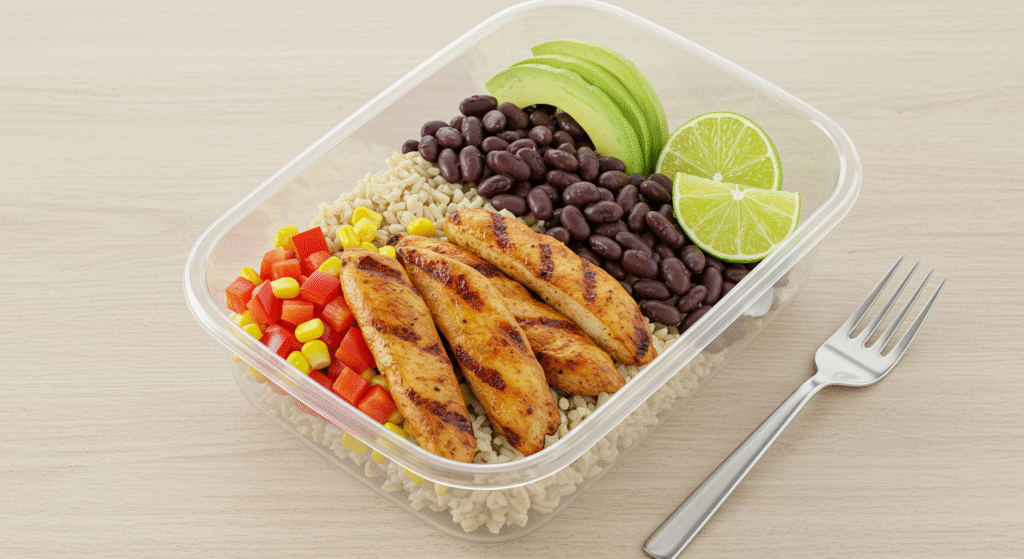
Quick Recipe Info
- Prep Time: 15 minutes
- Servings: 4
- Difficulty: Easy
- Diet Type: High-Protein, Gluten-Free, Balanced
Ingredients
- 2 cups cooked brown rice
- 2 grilled chicken breasts, diced
- 1 cup canned black beans, rinsed and drained
- 1 cup sweet corn kernels
- 1 red bell pepper, chopped
- 1 avocado, sliced
- Fresh cilantro and lime wedges to garnish
- Salt, pepper, and cumin to taste
Preparation Instructions
- Divide cooked brown rice evenly among 4 glass meal prep containers.
- Add equal portions of grilled chicken, black beans, corn, and chopped bell pepper.
- Top with fresh avocado slices and sprinkle chopped cilantro.
- Squeeze lime juice before serving.
- Refrigerate for up to 4 days.
Nutritional Snapshot – Chicken Burrito Bowl
| Nutrient | Per Serving |
|---|---|
| Calories | ~420 kcal |
| Carbohydrates | 38 g |
| Fiber | 9 g |
| Protein | 35 g |
| Fats | 14 g |
| Sugar | 3 g |
| Sodium | 420 mg |
Benefits of This Recipe
Supports Weight Loss
- High-protein and high-fiber combo enhances satiety and reduces overeating.
- Whole grains like brown rice offer slow-digesting energy, minimizing cravings.
Blood Sugar Control
- Balanced macronutrients help maintain steady blood glucose levels.
- Black beans and avocado contribute to a low glycemic load.
Other Health Benefits
- Rich in antioxidants from bell peppers and lime.
- Healthy fats from avocado support hormone balance and brain function.
Who Will Benefit from This Recipe?
- People aiming for sustainable fat loss with nutrient-dense, satiating meals.
- Diabetics seeking blood sugar stability through balanced, whole-food choices.
- Fitness enthusiasts who need protein-packed meals for recovery and performance.
- Busy professionals looking for easy, grab-and-go options with real nutrition.
Veggie-Packed Egg Muffins Recipe
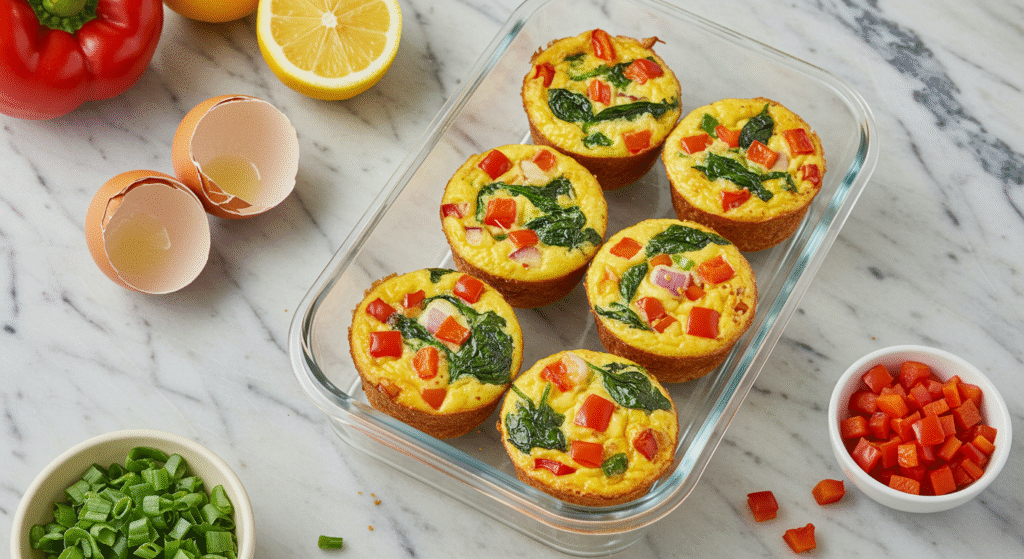
Quick Recipe Info
- Prep Time: 10 minutes
- Servings: 12 muffins
- Difficulty: Easy
- Diet Type: Low-Carb, Keto-Friendly, Gluten-Free
Ingredients
- 8 large eggs
- 1/2 cup fresh spinach, finely chopped
- 1/2 cup red bell pepper, diced
- 1/4 cup red onion, diced
- Salt, black pepper, and oregano to taste
- Optional: shredded cheese or nutritional yeast
Preparation Instructions
- Preheat oven to 375°F (190°C) and lightly grease a muffin tin.
- In a mixing bowl, whisk eggs with salt, pepper, and oregano.
- Stir in chopped spinach, bell pepper, and onion.
- Pour the mixture evenly into muffin cups (about 3/4 full).
- Bake for 20–25 minutes until fully set and slightly golden on top.
- Cool and store in an airtight container for up to 5 days.
Variation: Add feta cheese, turkey bacon, or mushrooms for flavor and texture diversity.
Nutritional Snapshot – Egg Muffins
| Nutrient | Per Muffin |
|---|---|
| Calories | ~70 kcal |
| Carbohydrates | 1 g |
| Fiber | 0.5 g |
| Protein | 6 g |
| Fats | 4 g |
| Sugar | 0.3 g |
| Sodium | 90 mg |
Benefits of This Recipe
Supports Weight Loss
- Very low in calories with high protein density.
- Keeps you full between meals, reducing snacking.
Blood Sugar Control
- Low-carb profile helps stabilize glucose levels.
- Ideal for diabetic-friendly or ketogenic diets.
Other Health Benefits
- Rich in antioxidants and fiber from colorful vegetables.
- Eggs support muscle maintenance and hormonal health.
Who Will Benefit from This Recipe?
- Anyone on a low-carb, keto, or diabetic-friendly diet looking for practical breakfast options.
- Busy professionals and parents needing quick, meal-preppable breakfasts.
- Fitness-focused individuals requiring portable, protein-rich snacks.
- Weight-loss seekers in need of satiating yet low-calorie meals.
Lean Turkey & Quinoa Stuffed Peppers Recipe
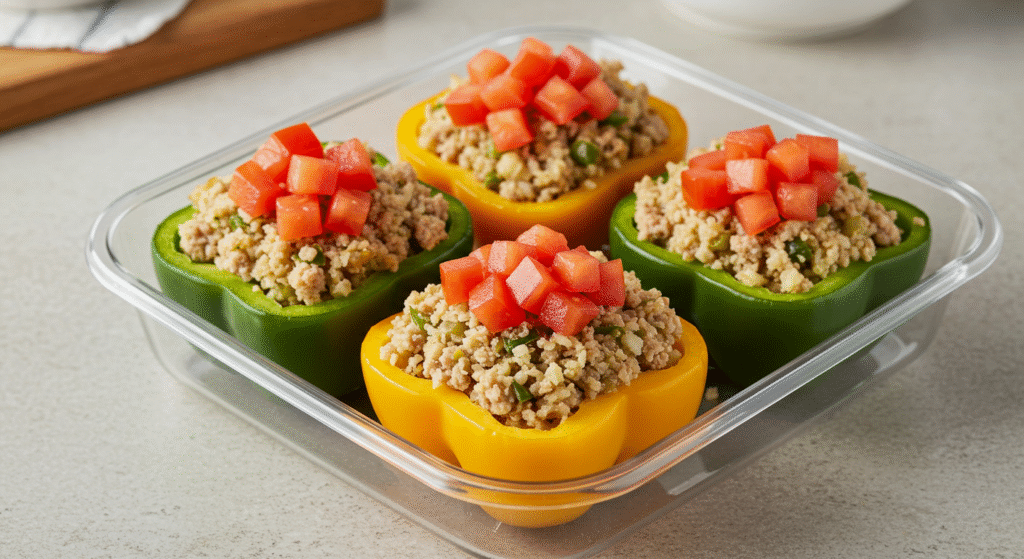
Quick Recipe Info
- Prep Time: 20 minutes
- Servings: 4
- Difficulty: Intermediate
- Diet Type: High-Protein, Low-Carb, Gluten-Free
Ingredients
- 4 large bell peppers, halved and seeds removed
- 1/2 lb (225g) lean ground turkey
- 1 cup cooked quinoa
- 1/2 cup onion, diced
- 1 can (14 oz) diced tomatoes, drained
- 2 cloves garlic, minced
- 1 tsp cumin
- 1 tsp paprika
- Salt and black pepper to taste
- Optional: shredded cheese or chopped parsley for topping
Preparation Instructions
- Preheat oven to 375°F (190°C).
- Sauté onions and garlic in a skillet until fragrant.
- Add ground turkey, breaking it up as it cooks until browned.
- Stir in cooked quinoa, tomatoes, cumin, paprika, salt, and pepper.
- Spoon the mixture into each bell pepper half.
- Place peppers in a baking dish and cover loosely with foil.
- Bake for 25–30 minutes. Remove foil for the last 10 minutes to brown the tops.
- Optional: top with cheese and bake an additional 5 minutes uncovered.
Variation: Swap quinoa for cauliflower rice to reduce carbs further.
Nutritional Snapshot – Stuffed Peppers
| Nutrient | Per Serving |
|---|---|
| Calories | ~360 kcal |
| Carbohydrates | 25 g |
| Fiber | 5 g |
| Protein | 30 g |
| Fats | 12 g |
| Sugar | 6 g |
| Sodium | 450 mg |
Benefits of This Recipe
Supports Weight Loss
- High protein and fiber increase satiety, supporting calorie control.
- Quinoa offers slow-digesting carbs with complete amino acids.
Blood Sugar Control
- Balanced macronutrients stabilize blood glucose.
- Ideal for reducing post-meal insulin spikes.
Other Health Benefits
- Bell peppers are rich in vitamin C and antioxidants.
- Turkey provides lean, muscle-building protein.
Who Will Benefit from This Recipe?
- Individuals seeking a filling, low-calorie dinner option.
- Low-carb dieters or those managing insulin resistance.
- Athletes or gym-goers needing lean muscle-supporting meals.
- Families looking for healthy and flavorful home-cooked meals.
Overnight Oats with Berries Recipe
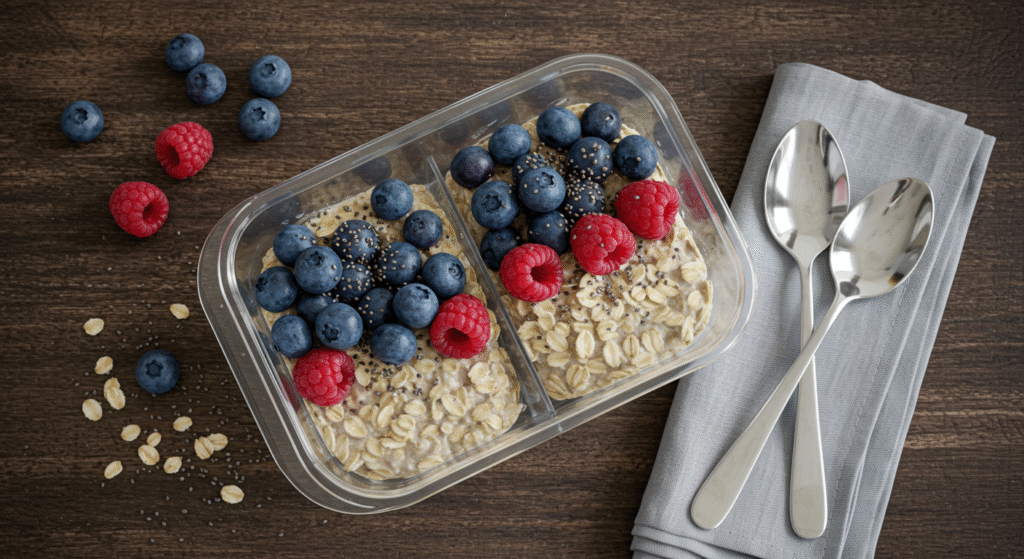
Quick Recipe Info
- Prep Time: 5 minutes
- Servings: 1
- Difficulty: Easy
- Diet Type: High-Fiber, Vegetarian, Diabetic-Friendly
Ingredients
- 1/2 cup rolled oats
- 1/2 cup unsweetened almond milk
- 1/4 cup Greek yogurt (plain, low-fat)
- 1 tsp chia seeds
- 1/2 cup mixed fresh berries (blueberries, strawberries, raspberries)
- Optional: 1 tsp honey or monk fruit sweetener
Preparation Instructions
- In a jar or container, combine oats, almond milk, Greek yogurt, and chia seeds.
- Stir until well mixed and smooth.
- Gently fold in fresh berries.
- Seal and refrigerate overnight (or at least 6 hours).
- Serve chilled. Add toppings like nut butter, cinnamon, or more berries if desired.
Variation: Use flaxseed instead of chia or swap Greek yogurt for coconut yogurt for a dairy-free version.
Nutritional Snapshot – Overnight Oats
| Nutrient | Per Serving |
|---|---|
| Calories | ~300 kcal |
| Carbohydrates | 40 g |
| Fiber | 8 g |
| Protein | 10 g |
| Fats | 8 g |
| Sugar | 7 g |
| Sodium | 90 mg |
Benefits of This Recipe
Supports Weight Loss
- High fiber and protein support fullness throughout the morning.
- Naturally low in calories and sugar, aiding calorie control.
Blood Sugar Control
- Rolled oats and berries provide low-glycemic carbohydrates.
- Chia seeds and yogurt help slow glucose absorption.
Other Health Benefits
- Berries are rich in polyphenols and antioxidants.
- Great for digestive health and sustained energy.
Who Will Benefit from This Recipe?
- Diabetics seeking blood sugar-friendly breakfasts.
- Anyone on a weight loss journey needing a quick, satisfying meal.
- Busy professionals and students looking for grab-and-go nutrition.
- Vegetarians wanting a complete meal with fiber, protein, and healthy fats.
Common Pitfalls and How to Stay Consistent
Meal prepping can be a transformative tool for weight loss—but only if it’s done with sustainability in mind. Many people start strong but give up due to burnout, boredom, or lack of planning. Here’s how to avoid the common traps and build long-term consistency.
Pitfall #1 – Overcomplicating Your Plan
The Problem: Trying to prep seven different meals for seven days straight is a recipe for exhaustion. Variety is important, but too much complexity becomes overwhelming.
The Fix: Stick to 2–3 core recipes per week and rotate proteins, sauces, and vegetables to keep things interesting. Use flexible base ingredients like rice, quinoa, and grilled chicken that can be repurposed creatively.
Pitfall #2 – Ignoring Your Own Schedule
The Problem: Prepping five meals a day when you’re barely home for lunch leads to wasted food and frustration.
The Fix: Build your prep plan around your real lifestyle. Ask: “When am I most likely to eat at home?”, “Do I need portable meals?”, or “Will I realistically eat this on Day 4?”
Pitfall #3 – Bland or Repetitive Meals
The Problem: Eating the same flavorless chicken and broccoli every day is one of the top reasons people quit meal prep.
The Fix: Use marinades, spice rubs, global cuisines (Mexican, Mediterranean, Asian), and sauces made from healthy fats and herbs. Texture also matters—mix raw and roasted veggies or hot and cold components.
Pitfall #4 – Lack of Portion and Macro Awareness
The Problem: Even healthy food can stall weight loss if portions are too large or unbalanced.
The Fix: Use macro guidelines or intuitive portioning methods. A typical meal might include:
- A palm-sized portion of protein
- A fist-sized portion of veggies
- A cupped-hand portion of complex carbs
- A thumb of healthy fat
How to Customize Meal Prep for Your Weight Loss Goals
No two weight loss journeys are the same. What works for one person might not work for another—especially when it comes to food. The beauty of meal prepping is that it’s infinitely adaptable. By personalizing your meals based on your body type, activity level, preferences, and health goals, you can accelerate results while keeping the process sustainable.
Tailoring Macros to Your Body and Activity Level
Why it matters: Your macro (protein, fat, carbs) needs depend heavily on factors like age, gender, weight, workout routine, and metabolism.
- Sedentary individual aiming for fat loss: Prioritize higher protein (30–40%), moderate fat (30%), and lower carbs (30–40%).
- Active individual (strength training or cardio): Lean toward balanced macros—40% carbs, 30% protein, 30% fat.
- Endomorph body type (naturally higher body fat): Lower carbs (~25–30%) and slightly higher fats and proteins often work better.
Adjusting Portion Sizes for Gradual vs. Rapid Weight Loss
Gradual weight loss (0.5–1 lb/week) is more sustainable and easier to maintain. If this is your goal:
- Aim for a daily deficit of 250–500 calories.
- Include moderate portions of carbs to support energy.
Rapid fat loss (1.5–2 lb/week) requires more discipline and structure:
- Cut calories by 500–750 per day.
- Keep meals lower in carbs but high in fiber and protein to fight hunger.
Customizing for Dietary Preferences or Restrictions
Meal prepping is highly flexible—vegetarian, vegan, keto, gluten-free, or paleo diets can all be accommodated.
- Vegan: Use legumes, tempeh, tofu, lentils, and seeds as protein sources.
- Keto: Focus on eggs, fatty fish, cheese, leafy greens, and low-carb vegetables.
- Paleo: Emphasize whole, unprocessed foods—meats, nuts, fruits, and vegetables.
Adapting Meal Prep Around Workouts
Timing meals around training can boost performance and recovery.
- Pre-workout: Eat carbs + protein 1–2 hours before (e.g., banana + almond butter or rice + lean chicken).
- Post-workout: Focus on fast-digesting protein + simple carbs to aid muscle repair (e.g., protein shake with berries or tuna with sweet potato).
For rest days, slightly reduce calories or carbs while increasing vegetables and hydration.
Conclusion
Meal prepping for weight loss isn’t just a trend—it’s a proven, practical lifestyle strategy. By taking control of your meals, you reduce stress, avoid temptation, and build a sustainable path toward a healthier body. Whether your goal is shedding a few pounds or making a long-term transformation, prepping meals in advance empowers you to succeed on your own terms.
With simple tools, strategic planning, and recipes tailored to your taste and goals, meal prepping for weight loss becomes not just doable—but enjoyable.
📌 Main Takeaways
- Meal prepping helps control portions, reduce cravings, and improve diet quality.
- Having essential tools and a prep strategy increases consistency and cuts stress.
- Simple recipes with balanced macros make healthy eating sustainable.
- Avoid common mistakes like overcomplicating or ignoring your real schedule.
- Customizing your meals around your body, goals, and preferences accelerates results.
To explore more on related strategies and deepen your success:
- Low-Carb Breakfast Recipes to Burn Fat – Want breakfast ideas that burn fat and taste amazing? Check our guide.
- Home Workouts – How to Stay Fit Without a Gym – No gym? No problem. Discover fitness routines that work anywhere.
- Moringa Magic – Is It Worth the Hype? – Curious about natural boosters? See our full review.












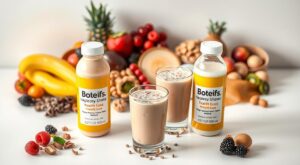
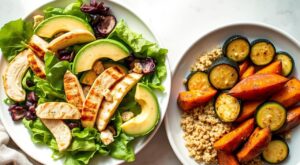

One Response